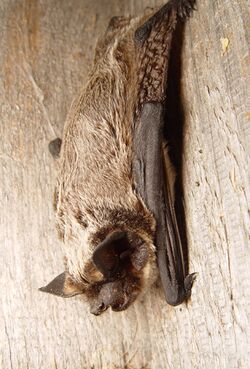Biology:Vespertilio
| Vespertilio | |
|---|---|

| |
| Parti-coloured bat, Vespertilio murinus | |
| Scientific classification | |
| Domain: | Eukaryota |
| Kingdom: | Animalia |
| Phylum: | Chordata |
| Class: | Mammalia |
| Order: | Chiroptera |
| Family: | Vespertilionidae |
| Genus: | Vespertilio Linnaeus, 1758 |
| Type species | |
| Vespertilio murinus Linnaeus, 1758
| |
Vespertilio is a genus of bats in the family Vespertilionidae. The common name for this family is vesper bats, which is a better-known classification than Vespertilio. They are also known as frosted bats.[citation needed]
Species within the genus Vespertilio are:
- Parti-coloured bat, Vespertilio murinus
- Asian parti-coloured bat, Vespertilio sinensis
History
Vespertilio is the oldest accepted genus name for bats. When Vespertilio was described in 1758, it was equivalent to the modern taxonomic order, encompassing all of Chiroptera (all bats), which Carl Linnaeus grouped with the primates due to certain characteristics mentioned by Linnaeus that bats seemed to share with actual primates. The second chiropteran genus, Pteropus, was described four years later in 1762. Vespertilio, as the oldest genus name, is thus the type genus of the family Vespertilionidae, which was not described until 1821.[1] Variably, until 1779, Vespertilio was considered either the only chiropteran genus, or one of two, including Pteropus. It was considered by some to be the only genus of bats until as late as 1817.[2]
References
- ↑ Hutcheon, James M.; Kirsch, John A. W. (2006). "A moveable face: Deconstructing the Microchiroptera and a new classification of extant bats". Acta Chiropterologica 8: 1–10. doi:10.3161/1733-5329(2006)8[1:AMFDTM2.0.CO;2]. ISSN 1733-5329.
- ↑ Miller Jr., Gerrit S. (1907). "The Families and Genera of Bats". United States National Museum Bulletin 57: 3. https://biodiversitylibrary.org/page/51112236.
- D.E. Wilson & D.M. Reeder, 2005: Mammal Species of the World: a Taxonomic and Geographic Reference. Third Edition. The Johns Hopkins University Press, Baltimore, MD.
Wikidata ☰ Q1762568 entry
 |

